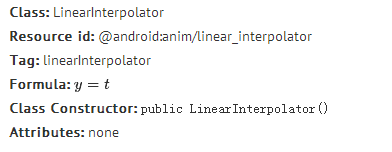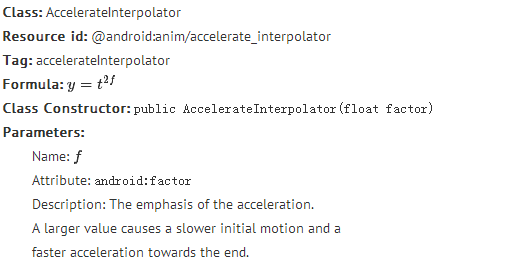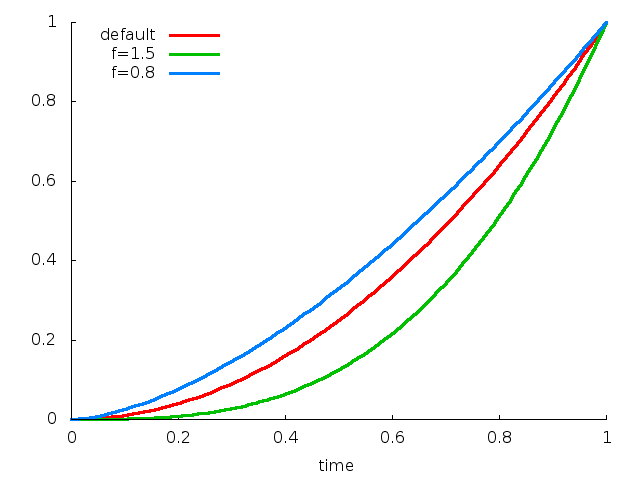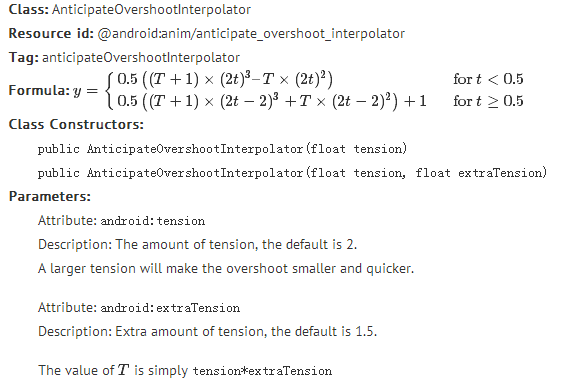Android中的Interpolator
首先介绍一个网站 https://www.desmos.com,这是一个通过函数来生成函数图像的网站,使用起来很灵活,可以 同时添加多个函数图像,分别指定他们的定义域。感谢道哥分享!
系统提供的Interpolator
LinearInterpolator 线性插值器
public class LinearInterpolator extends BaseInterpolator implements NativeInterpolatorFactory {
public LinearInterpolator() {
}
public LinearInterpolator(Context context, AttributeSet attrs) {
}
public float getInterpolation(float input) {
return input;
}
/** @hide */
@Override
public long createNativeInterpolator() {
return NativeInterpolatorFactoryHelper.createLinearInterpolator();
}
}AccelerateInterpolator 加速插值器
public class AccelerateDecelerateInterpolator extends BaseInterpolator implements NativeInterpolatorFactory {
public AccelerateDecelerateInterpolator() {
}
@SuppressWarnings({"UnusedDeclaration"})
public AccelerateDecelerateInterpolator(Context context, AttributeSet attrs) {
}
public float getInterpolation(float input) { //这里定义的函数
return (float)(Math.cos((input + 1) * Math.PI) / 2.0f) + 0.5f;
}
/** @hide */
@Override
public long createNativeInterpolator() {
return NativeInterpolatorFactoryHelper.createAccelerateDecelerateInterpolator();
}
}减速DecelerateInterpolator
/** * An interpolator where the rate of change starts out quickly and * and then decelerates. * */
@HasNativeInterpolator
public class DecelerateInterpolator extends BaseInterpolator implements NativeInterpolatorFactory {
public DecelerateInterpolator() {
}
/** * Constructor * * @param factor Degree to which the animation should be eased. Setting factor to 1.0f produces * an upside-down y=x^2 parabola. Increasing factor above 1.0f makes exaggerates the * ease-out effect (i.e., it starts even faster and ends evens slower) */
public DecelerateInterpolator(float factor) {
mFactor = factor;
}
public DecelerateInterpolator(Context context, AttributeSet attrs) {
this(context.getResources(), context.getTheme(), attrs);
}
/** @hide */
public DecelerateInterpolator(Resources res, Theme theme, AttributeSet attrs) {
TypedArray a;
if (theme != null) {
a = theme.obtainStyledAttributes(attrs, R.styleable.DecelerateInterpolator, 0, 0);
} else {
a = res.obtainAttributes(attrs, R.styleable.DecelerateInterpolator);
}
mFactor = a.getFloat(R.styleable.DecelerateInterpolator_factor, 1.0f);
setChangingConfiguration(a.getChangingConfigurations());
a.recycle();
}
public float getInterpolation(float input) {
float result;
if (mFactor == 1.0f) {
result = (float)(1.0f - (1.0f - input) * (1.0f - input));
} else {
result = (float)(1.0f - Math.pow((1.0f - input), 2 * mFactor));
}
return result;
}
private float mFactor = 1.0f;
/** @hide */
@Override
public long createNativeInterpolator() {
return NativeInterpolatorFactoryHelper.createDecelerateInterpolator(mFactor);
}
}AccelerateDecelerateInterpolator 加速减速插值器
@HasNativeInterpolator
public class AccelerateDecelerateInterpolator extends BaseInterpolator implements NativeInterpolatorFactory {
public AccelerateDecelerateInterpolator() {
}
@SuppressWarnings({"UnusedDeclaration"})
public AccelerateDecelerateInterpolator(Context context, AttributeSet attrs) {
}
public float getInterpolation(float input) { //这里定义函数
return (float)(Math.cos((input + 1) * Math.PI) / 2.0f) + 0.5f;
}
/** @hide */
@Override
public long createNativeInterpolator() {
return NativeInterpolatorFactoryHelper.createAccelerateDecelerateInterpolator();
}
}BounceInterpolator 弹跳插值器
package android.view.animation;
import android.content.Context;
import android.util.AttributeSet;
import com.android.internal.view.animation.HasNativeInterpolator;
import com.android.internal.view.animation.NativeInterpolatorFactory;
import com.android.internal.view.animation.NativeInterpolatorFactoryHelper;
/** * An interpolator where the change bounces at the end. */
@HasNativeInterpolator
public class BounceInterpolator extends BaseInterpolator implements NativeInterpolatorFactory {
public BounceInterpolator() {
}
@SuppressWarnings({"UnusedDeclaration"})
public BounceInterpolator(Context context, AttributeSet attrs) {
}
private static float bounce(float t) {
return t * t * 8.0f;
}
public float getInterpolation(float t) {
// _b(t) = t * t * 8
// bs(t) = _b(t) for t < 0.3535
// bs(t) = _b(t - 0.54719) + 0.7 for t < 0.7408
// bs(t) = _b(t - 0.8526) + 0.9 for t < 0.9644
// bs(t) = _b(t - 1.0435) + 0.95 for t <= 1.0
// b(t) = bs(t * 1.1226)
t *= 1.1226f;
if (t < 0.3535f) return bounce(t);
else if (t < 0.7408f) return bounce(t - 0.54719f) + 0.7f;
else if (t < 0.9644f) return bounce(t - 0.8526f) + 0.9f;
else return bounce(t - 1.0435f) + 0.95f;
}
/** @hide */
@Override
public long createNativeInterpolator() {
return NativeInterpolatorFactoryHelper.createBounceInterpolator();
}
}AnticipateInterpolator 回荡秋千插值器
public class AnticipateInterpolator extends BaseInterpolator implements NativeInterpolatorFactory {
private final float mTension;
public AnticipateInterpolator() {
mTension = 2.0f;
}
/** * @param tension Amount of anticipation. When tension equals 0.0f, there is * no anticipation and the interpolator becomes a simple * acceleration interpolator. */
public AnticipateInterpolator(float tension) {
mTension = tension;
}
public AnticipateInterpolator(Context context, AttributeSet attrs) {
this(context.getResources(), context.getTheme(), attrs);
}
/** @hide */
public AnticipateInterpolator(Resources res, Theme theme, AttributeSet attrs) {
TypedArray a;
if (theme != null) {
a = theme.obtainStyledAttributes(attrs, R.styleable.AnticipateInterpolator, 0, 0);
} else {
a = res.obtainAttributes(attrs, R.styleable.AnticipateInterpolator);
}
mTension = a.getFloat(R.styleable.AnticipateInterpolator_tension, 2.0f);
setChangingConfiguration(a.getChangingConfigurations());
a.recycle();
}
public float getInterpolation(float t) {
// a(t) = t * t * ((tension + 1) * t - tension)
return t * t * ((mTension + 1) * t - mTension);
}
/** @hide */
@Override
public long createNativeInterpolator() {
return NativeInterpolatorFactoryHelper.createAnticipateInterpolator(mTension);
}
}AnticipateOvershootInterpolator
/** * An interpolator where the change starts backward then flings forward and overshoots * the target value and finally goes back to the final value. */
@HasNativeInterpolator
public class AnticipateOvershootInterpolator extends BaseInterpolator implements NativeInterpolatorFactory {
private final float mTension;
public AnticipateOvershootInterpolator() {
mTension = 2.0f * 1.5f;
}
/** * @param tension Amount of anticipation/overshoot. When tension equals 0.0f, * there is no anticipation/overshoot and the interpolator becomes * a simple acceleration/deceleration interpolator. */
public AnticipateOvershootInterpolator(float tension) {
mTension = tension * 1.5f;
}
/** * @param tension Amount of anticipation/overshoot. When tension equals 0.0f, * there is no anticipation/overshoot and the interpolator becomes * a simple acceleration/deceleration interpolator. * @param extraTension Amount by which to multiply the tension. For instance, * to get the same overshoot as an OvershootInterpolator with * a tension of 2.0f, you would use an extraTension of 1.5f. */
public AnticipateOvershootInterpolator(float tension, float extraTension) {
mTension = tension * extraTension;
}
public AnticipateOvershootInterpolator(Context context, AttributeSet attrs) {
this(context.getResources(), context.getTheme(), attrs);
}
/** @hide */
public AnticipateOvershootInterpolator(Resources res, Theme theme, AttributeSet attrs) {
TypedArray a;
if (theme != null) {
a = theme.obtainStyledAttributes(attrs, AnticipateOvershootInterpolator, 0, 0);
} else {
a = res.obtainAttributes(attrs, AnticipateOvershootInterpolator);
}
mTension = a.getFloat(AnticipateOvershootInterpolator_tension, 2.0f) *
a.getFloat(AnticipateOvershootInterpolator_extraTension, 1.5f);
setChangingConfiguration(a.getChangingConfigurations());
a.recycle();
}
private static float a(float t, float s) {
return t * t * ((s + 1) * t - s);
}
private static float o(float t, float s) {
return t * t * ((s + 1) * t + s);
}
public float getInterpolation(float t) {
// a(t, s) = t * t * ((s + 1) * t - s)
// o(t, s) = t * t * ((s + 1) * t + s)
// f(t) = 0.5 * a(t * 2, tension * extraTension), when t < 0.5
// f(t) = 0.5 * (o(t * 2 - 2, tension * extraTension) + 2), when t <= 1.0
if (t < 0.5f) return 0.5f * a(t * 2.0f, mTension);
else return 0.5f * (o(t * 2.0f - 2.0f, mTension) + 2.0f);
}
/** @hide */
@Override
public long createNativeInterpolator() {
return NativeInterpolatorFactoryHelper.createAnticipateOvershootInterpolator(mTension);
}
}CycleInterpolator 正弦周期变化插值器
@HasNativeInterpolator
public class CycleInterpolator extends BaseInterpolator implements NativeInterpolatorFactory {
public CycleInterpolator(float cycles) {
mCycles = cycles;
}
public CycleInterpolator(Context context, AttributeSet attrs) {
this(context.getResources(), context.getTheme(), attrs);
}
/** @hide */
public CycleInterpolator(Resources resources, Theme theme, AttributeSet attrs) {
TypedArray a;
if (theme != null) {
a = theme.obtainStyledAttributes(attrs, R.styleable.CycleInterpolator, 0, 0);
} else {
a = resources.obtainAttributes(attrs, R.styleable.CycleInterpolator);
}
mCycles = a.getFloat(R.styleable.CycleInterpolator_cycles, 1.0f);
setChangingConfiguration(a.getChangingConfigurations());
a.recycle();
}
public float getInterpolation(float input) {
return (float)(Math.sin(2 * mCycles * Math.PI * input));
}
private float mCycles;
/** @hide */
@Override
public long createNativeInterpolator() {
return NativeInterpolatorFactoryHelper.createCycleInterpolator(mCycles);
}
}OvershootInterpolator
/** * An interpolator where the change flings forward and overshoots the last value * then comes back. */
@HasNativeInterpolator
public class OvershootInterpolator extends BaseInterpolator implements NativeInterpolatorFactory {
private final float mTension;
public OvershootInterpolator() {
mTension = 2.0f;
}
/** * @param tension Amount of overshoot. When tension equals 0.0f, there is * no overshoot and the interpolator becomes a simple * deceleration interpolator. */
public OvershootInterpolator(float tension) {
mTension = tension;
}
public OvershootInterpolator(Context context, AttributeSet attrs) {
this(context.getResources(), context.getTheme(), attrs);
}
/** @hide */
public OvershootInterpolator(Resources res, Theme theme, AttributeSet attrs) {
TypedArray a;
if (theme != null) {
a = theme.obtainStyledAttributes(attrs, R.styleable.OvershootInterpolator, 0, 0);
} else {
a = res.obtainAttributes(attrs, R.styleable.OvershootInterpolator);
}
mTension = a.getFloat(R.styleable.OvershootInterpolator_tension, 2.0f);
setChangingConfiguration(a.getChangingConfigurations());
a.recycle();
}
public float getInterpolation(float t) {
// _o(t) = t * t * ((tension + 1) * t + tension)
// o(t) = _o(t - 1) + 1
t -= 1.0f;
return t * t * ((mTension + 1) * t + mTension) + 1.0f;
}
/** @hide */
@Override
public long createNativeInterpolator() {
return NativeInterpolatorFactoryHelper.createOvershootInterpolator(mTension);
}
}自定义Interpolator
Interpolator源码:
package android.view.animation;
import android.animation.TimeInterpolator;
/** * An interpolator defines the rate of change of an animation. This allows * the basic animation effects (alpha, scale, translate, rotate) to be * accelerated, decelerated, repeated, etc. */
public interface Interpolator extends TimeInterpolator {
// A new interface, TimeInterpolator, was introduced for the new android.animation
// package. This older Interpolator interface extends TimeInterpolator so that users of
// the new Animator-based animations can use either the old Interpolator implementations or
// new classes that implement TimeInterpolator directly.
}我们来写自己的类来实现该接口
import android.view.animation.Interpolator;
public class MyInterpolator implements Interpolator {
private float mFactor;
private int i;
public MyInterpolator(int i){
this.i = i;
}
@Override
public float getInterpolation(float input) { //定义我们的函数,input: 0 ~ 1
switch(i){
case 1:mFactor = input;
break;
case 2:mFactor = input*input*input;
break;
}
return mFactor;
}
}来个复杂的:
@Override
public float getInterpolation(float t) { //定义我们的函数,t: 0 ~ 1
if(t<0.2094) return (float)(-34*(t-0.18)*(t-0.18)+1.08);
else if(t <0.404) return (float)(5.9*(t-0.34)*(t-0.34)+0.95);
else if(t < 0.6045) return (float)(-3*(t-0.53)*(t-0.53)+1.02);
else if(t < 0.8064) return (float)((t-0.72)*(t-0.72)+0.99);
else return (float)(-0.3*(t-0.915)*(t-0.915)+1.001);
return mFactor;
}












